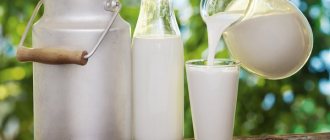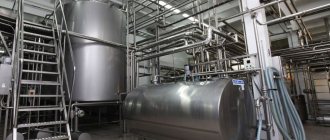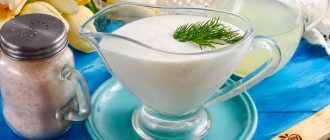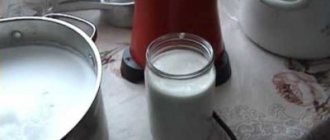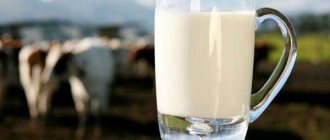The problem of long-term storage of any food products has always been relevant for people. But how to preserve food without losing its taste and beneficial properties? Whatever was invented for these purposes. Meat, vegetables, milk - all this was literally recently buried in a hole for storage, covered with straw and ice on top. However, modern technologies do not stand still. Currently, there are special freezers and refrigeration chambers that allow you to keep products unchanged for a very long time. Another best way is the principle of processing fresh products into something new. For example, you can make jam, jam, jam from fruits. If we talk about vegetables, then this includes various canned salads and pickles. In the dairy industry, this approach makes it possible to obtain a wide range of products from milk. Cream, butter, sour cream, and cottage cheese can be obtained by separating milk. This is exactly what we will talk about in our article.
Separation and normalization of milk
Milk separation –
This is its division into two fractions of different densities: high-fat (cream) and low-fat (skimmed milk). Separation is carried out under the action of centrifugal force in the separator drum. Milk, distributed in the drum between plates in the form of thin layers, moves at low speed, which creates favorable conditions for the most complete separation of the high-fat fraction (fat globules) in a short time. The milk separation process obeys Stokes' law:
v = (2/9) (2р/60) Rr2n2 (s-s1/m)
where v is the rate of release of fat globules, cm/s; R – average radius of the working part of the separator plate, cm; r is the radius of the fat globule, cm; n – rotation frequency of the separator drum, C -1; с , с 1 , – density of plasma and fat, kg/m3; m – dynamic viscosity, Pa * s.
In accordance with this law, the rate of release of the fat fraction from milk is directly dependent on the size of the fat globules, the density of the milk plasma, the dimensions and rotation speed of the drum, and inversely proportional to the viscosity of the milk. With an increase in the size of fat globules and the density of milk plasma, the process of separation and separation of cream accelerates. The higher the content of nonfat solids in milk, the higher the density of plasma and whole milk. Consequently, milk of higher density will have better conditions for separation. An increase in milk viscosity leads to a decrease in the rate of release of the fat fraction.
In addition, the acidity and temperature of the milk have a significant impact on separation.
An increase in the acidity of milk leads to a change in the colloidal state of its proteins, sometimes accompanied by the loss of flakes; As a result, viscosity increases, which makes separation difficult.
Increasing the temperature of milk helps to reduce its viscosity and the transition of fat into a liquid state, which improves separation. The optimal separation temperature is 35.45 °C. Heating the milk to this temperature ensures good skimming. The operating diagram of the separating device is shown in Figure 1.
Along with separation at 35–45 °C, high-temperature separation at 60–85 °C is sometimes used. As the separation temperature increases, the productivity of the separator and the quality of degreasing increase. However, high-temperature separation also has a number of disadvantages: an increase in the fat content in skim milk due to partial loss of albumin, which prevents the release of fat; strong foaming of cream and skim milk; increased fragmentation of fat globules.
Fig.1. Scheme of operation of the separating device: a –
milk purifier;
b –
cream separator;
/ – original milk; 2 –
light fraction (purified milk or cream);
3 –
particles forming sediment;
4 –
sediment (mucus); 5 – heavy fraction (skimmed milk)
Much attention is paid to separation at low temperatures, the so-called cold milk separation. However, separation at low temperatures using conventional separators leads to a decrease in their productivity by almost half due to an increase in viscosity and partial crystallization of fat.
The separation process in the separator is carried out in the following sequence (Fig. 1, b). Whole milk flows through a central tube into a plate holder, from which it rises through channels formed by holes in the plates to the upper part of the set of plates and spreads between them. In the inter-plate space, fat globules, as a lighter fraction of milk, move towards the center of the drum, then along the gap between the edge of the plate and the plate holder they rise up and enter the cream chamber. Then, under pressure, the cream enters the pipe on which a cream quantity meter (rotameter) and a control valve are installed. Skim milk, as a heavier fraction, is directed to the periphery of the drum (into the mud space), rises up and enters the pipe on which a pressure gauge and a control valve (faucet) are installed.
The control valve is designed to regulate the fat content of the resulting cream, which varies depending on the amount of cream and skim milk. With a constant amount and mass fraction of fat in the incoming milk, a decrease in the amount of outgoing cream leads to an increase in the mass fraction of fat in it and, conversely, an increase in the amount of cream reduces the mass fraction of fat in it.
Based on the ratio of the masses of cream and skim milk, you can find the required fat content of the cream. Having determined by calculation the ratio between the masses of cream and skim milk, this ratio is established using an adjusting device.
Milk is supplied to dairy enterprises with different contents of fat and nonfat milk solids (SMR), and in the finished product fat and SMR must be in a certain quantity or ratio. In this regard, normalization of raw materials is necessary.
Normalization –
This is the regulation of the composition of raw materials to obtain a finished product that meets the requirements of the standard.
When normalizing source (whole) milk by fat, there can be two options: there is more fat in whole milk than required in production, and there is less fat in whole milk than required. In the first option, the fat is partially removed by separation or skim milk is added to the original milk. In the second option, to increase the fat content of the original milk, cream is added to it. The masses of cream and skim milk required to be added to the original milk are calculated using material balance equations, which can be prepared for any component of the milk.
Separation products
A distinctive feature of the composite separation products is the preservation of all the qualities of the raw materials. Chemical reactions are not involved in this process. They appear when raw materials or skim milk sour when bacteria act.
Average chemical composition of by-products, %:
| Substances | Return | Buttermilk | Cheese whey | Curd whey |
| Fat | 0,1 | 0,4 | 0,4 | 0,3 |
| Squirrels | 3,4 | 3,2 | 0,8 | 0,8 |
| Milk sugar | 4,6 | 4,7 | 4,8 | 4,2 |
| Mineral salts | 0,7 | 0,7 | 0,5 | 0,6 |
| Total dry matter | 8,8 | 9,0 | 6,5 | 5,9 |
Directions for use
Large quantities of skim milk powder are obtained from buttermilk. It is used for the production of whole product substitutes, which are needed in animal husbandry for feeding calves.
Whey is also used by farmers, but for feeding pigs.
Low-fat cottage cheese is prepared from skim milk, which has a maximum concentration of healthy protein. It is popular in dietary nutrition and is sold in retail chains along with other types of milk.
The most common separation products:
- cream;
- butter;
- serum.
Milk fats are separated due to their lighter weight. Due to its lower density, the cream accumulates naturally. For example, if you leave whole milk in a jar overnight, in the morning you will see a clear line of separation between the two components.
Butter is similar to the previous type of product, but has a higher fat content. Because of this, it is hard and dense, and cream is thicker than milk, but always remains liquid.
The whey remains after decanting the curdled product. It is the liquid part in which proteins and some fats are dissolved.
Fermented milk products do not lose their nutritional qualities, but, on the contrary, are considered the best for absorption. Known species:
- cheese;
- cottage cheese;
- kefir.
Buttermilk is used to prepare many fermented milk products. Experts especially value its dietary composition:
- lactose, which helps absorb vitamins C and B;
- choline, which is responsible for liver function;
- lecithin, necessary for cells and tissues.
Unlike buttermilk, whey also contains proteins, which are considered better for absorption by the human body in comparison with egg proteins.
Whey is a by-product in the production of cheeses and cottage cheese. It is often used in the bakery industry and livestock farming.
Some dairy products are produced using modern technologies. As a rule, these are concentrated versions obtained by removing water:
- dry;
- condensed.
Skim milk powder is often used in:
- bakery industry;
- livestock farming
Many types of confectionery products cannot be prepared without condensed milk. It is added to tea and coffee as a substitute for cream and sugar.
What is it and what is it for?
Milk separation is an important stage of processing, during which the milk is separated into cream and a skim part (skim). This process not only extends the shelf life, allows you to obtain different types of fermented milk foods, but also contributes to the mechanical purification of this natural product from various impurities.
Operating principle and design of a household milk separator
Milk is a product of complex composition, in which fats have a much lower density than the rest of the milk mass. During separation, the milk, rotating, moves in a circle, passes through several perforated plates stacked on top of each other, while centrifugal forces push the heavier and denser fraction—reverse—to the walls of the centrifuge. Light and less dense fat remains in the .
In a separator powered by an electric motor, the milk rotation speed is higher than that of a mechanical device. Therefore, the separation of cream occurs quickly. Industrial electric separators of large factories receive hundreds of kilograms of cream and skim milk per day. Medium-sized machines, designed for small factories and farms, can produce up to 50-80 kg of product per hour.
How was the procedure carried out before and now?
Some time ago, the separation process was as follows: milk was placed in a cold place, where the heavier part (water) went to the bottom, and the cream remained on top. This method was called gravitational. Its disadvantages were very obvious:
- Milk was taking up space in the refrigerator.
- It could turn sour before being separated.
- The quality of the cream with this separation was low.
Today, mechanical processing is carried out on special equipment, which is called separators. There are milk separators and cream separators.
Principle of operation
Small household milk separators usually weigh about 3-4 kg and are capable of producing more than 50 liters of dairy products in one hour. The power of such devices is quite enough for a small farm. The resulting cream is superior in quality to that sold in stores, since only freshly collected milk is used. In addition, the owners monitor compliance with sanitary standards, the production process, and the health of the cows much better.
A household milk separator can be used to whip butter. To do this, it is necessary to settle the finished cream for some time, and then carry out the separation process. Then the product thus obtained should be compressed under pressure and left in a cool place for storage. Some milk separators come with a butter churning option out of the box. In addition, models are sold that work exclusively as butter churns.
How to choose equipment?
- If you have several cows/goats and you decide to open a small business producing fermented milk products, then a machine with a capacity of at least 100 l/hour is suitable for you. For example, “Motor SICH SCM-100-19” or “Falcon MS 100 metal”.
- If you are a novice farmer or are going to use the device at home, then the best option for you would be a device with a capacity of 80 l/hour. For example, “Farmer ES-01 80 liters” or “Penzmash Salyut ESB02-04 80 liters”.
- If you want to make cream or butter during your summer holiday in the country, i.e. If you do not do this regularly, but seasonally, then a separator of 50 l/hour will be enough for you. Such as “Ural M” and “Hydrounit Beryozka”.
- If you are counting on a full-fledged farm, choose equipment with a productivity of 500 l/h. Such as "Motor SICH 500".
The separator should be installed on the edge of a flat surface in a heated room.
Which separator to choose?
To separate milk at home, it will be important to choose a device for this process. Thrifty owners can use a manual separator. This option will not require energy expenditure, but will work only thanks to physical strength. It should also be noted that there is no difference in performance between the electric and manual versions. A manual apparatus for separating milk at home is equipped with a special gearbox, thanks to which the drum can be given a higher rotational speed.
However, on the other hand, processing surplus whole milk using an electric machine completely eliminates the need to use physical force. Here, everyone decides for themselves which model of equipment to choose for separating milk at home.
Factors influencing the process
There are several factors that affect the quality of separation:
- Liquid density. The higher it is, the lower the quality of the resulting product. The degree of thickness can be reduced by heating the milk.
- Fat content of milk. The larger it is, the slower the separation process occurs. In order to increase its speed, it is necessary to increase the number of cleaning plates that are located in the device itself.
- Incorrect technical processes. They also affect the separation rate, slowing it down. This happens because rough pumps deform fat particles during industrial pumping of milk. When the particles are round in shape and large in size, separation occurs much faster.
The temperature of the initial product is the main criterion that affects the quality of the final result. The optimal mode for household separators is 35-45°C.
Industrial production technology
In production, milk separation occurs at a temperature of 35-45°C.
The process itself includes several stages:
- Reception of raw materials from suppliers.
- Preparatory process.
- Directly the production itself.
- Sending for verification.
In production, one should be guided by the following principle: before separation, it is undesirable to subject milk to significant mechanical stress - mixing, pumping, shaking, since this causes crushing of fat globules and an increase in fat loss into skim milk.
A little about the thickness of cream
Normal cream thickness ranges between 24 and 28% fat.
- In order to be sure whether the cream is thick enough, you need to know how fat the milk is being separated and what percentage of the cream is separated by the separator.
- With an average milk fat content of 4%, the separator should separate 15% of the cream.
- With 3% fat in milk, the separator needs to separate 12% cream, etc.
Due to the fact that the percentage of fat in the milk of Russian cows is on average about 4%, you need to set the butter screw to 15%.
Now you know all the secrets of high-quality milk separation. Follow all the principles that were described in the article and then you will be able to enjoy various types of fermented milk products without causing harm to your health.
Cow's
To carry out the procedure, it is necessary to take into account a number of indicators - acidity, fat content, what temperature the product should be so that it can be separated, whether it is permissible to use fresh milk and other nuances.
- Milk purification. To prevent dirt from getting into your plate or separator, you should pass the milk through a filter. You can use special paper or gauze to get rid of small, foreign particles, such as wool.
- Fat content of milk. This also needs to be monitored. The most optimal value for separation is 3%.
- Acidity. Not higher than 20°T.
- Temperature. The milk should be preheated to 30-35°C and only then should separation begin.
- Before separation, the milk should NOT be subjected to excessive mechanical movements - stirring, etc.
- For storage, milk must be cooled to 10°C.
- To reduce bacterial contamination, you can pasteurize milk by heating it to 65°C for 20-30 minutes. It can then be cooled and sent either to storage or to a separator.
DIY milk separator
Milk contains many useful substances, vitamins and minerals. The benefits of milk are evidenced by the fact that by drinking 0.5 liters of milk a day, the body receives all the nutrients it needs. True, this applies to a greater extent to fresh milk; sterilized milk has significantly fewer beneficial properties.
Milk contains lactose, which is necessary for the functioning of the heart, liver, and kidneys. The main protein in milk, casein, contains the amino acid methionine, which is also beneficial for the liver and kidneys. Do-it-yourself milk separator However, some people do not have the lactase enzyme in their gastrointestinal tract, which breaks down lactose (milk sugar). Such people cannot tolerate milk, but can benefit from fermented milk products. Lactic acid bacteria suppress the activity of intestinal microflora and thereby reduce the adverse effects of lactose.
Milk contains beneficial vitamins. Vitamin A, which is necessary for the growth of a child and is also essential for maintaining vision. Vitamin B1 (thiamine), necessary for the absorption of sugar.
The body receives the calcium it needs from milk and dairy products. After all, calcium tends to be washed out of bones with age and the bones become fragile. Calcium is necessary both for children’s bodies to form the skeleton, and for older people to prevent osteoporosis. And lactose contained in milk helps the body better absorb calcium.
The beneficial properties of milk will be enhanced if you combine milk intake with vitamin D to enhance the absorption of calcium in the intestines. Fish, fish oil, and caviar are rich in vitamin D.
Fresh milk has bactericidal properties only for 3 - 4 hours after milking. DIY milk separator Then microorganisms and bacteria begin to multiply in it. Raw milk must be boiled before consumption, even if you buy it from reputable places.
Boiling kills bacteria and most spores.
Sterilization kills all bacteria and their spores. True, during sterilization (heating to 125 - 145 degrees) vitamin C and useful proteins - albumin and globulin - are destroyed. But such a product can be stored for a long time.
Pasteurization of milk - heating to 74 - 76 degrees is the most optimal way to process the product; during pasteurization, most vitamins are preserved. but the shelf life of pasteurized milk is much shorter: at a temperature of 0 to 6 degrees, the shelf life is no more than 5 days. It is not recommended to boil pasteurized milk.
The beneficial properties of milk include its beneficial effect on the gastric mucosa. Milk is especially useful for gastritis (goat milk is most useful). Do-it-yourself milk separator Milk is also useful for sleep disorders. Drink milk with honey before bed, it is very calming.
In general, milk with honey has a whole range of healing properties, strengthens the immune system, and increases the body’s resistance.
Drink milk in small sips, as milk can curdle in the stomach into hard-to-digest clumps. In case of food poisoning, on the contrary, drink the milk in one gulp, then the toxic products will come out faster.
Baked goods with a high sugar content will turn a more uniform brown color if you add powdered sugar to the dough instead of granulated sugar.
How to properly separate at home?
Goat
The separation of goat and cow milk is slightly different. Let's look at this process for a goat first:
- Prepare milk for separation (see principles above).
- Heat it to the desired temperature (37-40°C).
- Warm up the separator with warm water, pouring it into the milk receiver.
- Pour milk into the separator and start rotating.
- If there is a smooth noise, open the separator key. It is important to do this slowly and carefully!
- Adjust the toggle switch so that the resulting sour cream flows out in a thin stream.
Separation is complete. Now let's move on to the second stage:
- Run the milk again to remove any remaining fat from the separator.
- Place the separated cream in a warm place for a day.
To make the sour cream tastier, do not fill the jar completely (about 4/5 of the total volume).
Cow
Find out how cow's milk is passed through a separator.
To obtain cream by separating cow's milk, you should follow the following plan:
- Preparatory stage. It is necessary to warm up the separator by passing hot water (about 70°C) through its drum. After achieving normal rotation, you can pour in milk, which has already been preheated to 30°C.
- Main stage. Tie gauze onto the separator receiver, and then increase the handle rotation speed to 65 rpm. If you are using an electric separator, plug it into the network. After this, open the receiver tap. In this case, you should periodically add milk to the separator so as not to interrupt the process.
You can adjust the fat content of the cream using the drain screw. To increase the fat content of the cream, turn the screw to the right; to decrease it, turn it to the left.
When the process is completed, pour 1 liter into the receiver. reverse and, without rotating, turn off the device. When everything has flowed out of the cream hole, you can turn off the receiver tap.
- The final stage. The last thing to do is to disassemble the device and wash each part with cold water, warm soda solution and clean water. Then you need to lay out the parts separately from each other to dry.
All parts in the separator must fit tightly to each other. There should be no cracks or gaps between them.
The first (simple) way to prepare cream
Making cream from homemade milk in this way is quite simple. You just need to take the milk, cover it with a lid and put it in the refrigerator for twelve hours. It is better not to touch the pan at this time. After the required time has passed, cream will appear on top. You just need to take a spoon and collect them. If desired, you can add a little sugar to the mass and beat with a mixer. In this case, you will get wonderful homemade cream. By continuing to beat at a higher speed, we will be able to make real butter.
While talking about how to prepare cream, we want to tell you about one more method. Most likely, this option will be the most acceptable for urban residents. In a metropolitan area, it is not always possible to purchase real full-fat homemade milk, and not everyone wants to tinker with a separator. Therefore, we offer you a more interesting option. It will allow you to get a good dairy product for desserts and cakes.
How to distinguish from whole?
There are several universal parameters for how to distinguish whether your milk has been separated or whole:
The main difference between skim milk using a separator and whole milk, which cannot be seen with the naked eye, is the reduced fat content. This property allows the use of milk during diets. In addition, it is rich in various minerals (zinc, iron, manganese) and vitamins such as A, B (folic acid, thiamine, pantothenic acid), C, D and others.
Knowing all these features, you can easily understand which milk has undergone mechanical processing and which has not.
What does normalized milk mean?
Milk is a product that accompanies us from the first days of life. ... After homogenization, the milk is separated (separated) from the fat. To bring the product to the desired fat content, skim milk is mixed with cream or whole milk. The resulting product is called Normalized milk.
Interesting materials:
How to remove the header and footer on the last page? How to remove Bish's lumps? How to delete comments in a presentation? How to delete comments in Word? How to remove commercial use of Teamweaver? How to delete a company on Google? How to remove a contact from favorites on Android? How to remove a contact from favorites on iPhone? How to remove a contact from your list on Skype? How to delete a contact from the Android phone book?
Possible problems and ways to solve them
Problems related to technical side and equipment:
- Problem #1: Protein flakes quickly fill the drum's dirt container. This is due to the fact that milk with high acidity is involved in the separation.
Consequences: Reduced milk separation rate.
Solution: Regular manual cleaning of the separator. Problem No. 2: An increase in lactic acid bacteria, which occurs due to an increase in temperature during separation to 45°C.
Consequences: Rapid deterioration of the product.
Solution: Use milk that is heated to 20-30°C. Problem #3: Reduced process efficiency due to increasing the distance between the drum plates.
Solution: Increasing the number of these trays and regular operation of the separator.
Reasons why the separator does not separate cream from milk:
- You are adding too much milk. Solving this problem is quite simple: you can regulate the feed using special flags.
- Insufficient separator speed. To avoid this, accelerate the rotor of the device more strongly.
- You are pouring too hot milk into the separator. The milk temperature should not exceed 40°C.
- Error while assembling the device. You have put something in the wrong place. To solve this problem, you can contact a professional or use the instructions.
- Gaps between device parts. Check their presence carefully when assembling the device.
